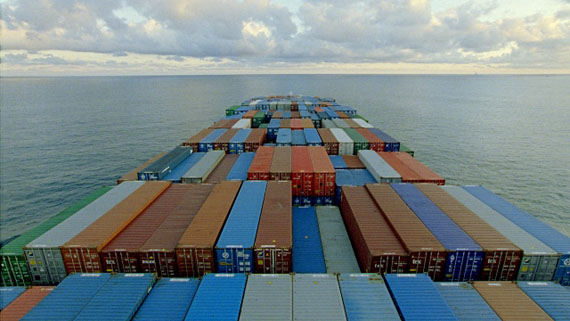
The Forgotten Space, 2010
Filmstill
© Estate of Allan Sekula
Courtesy WILDart FILM, Vienna
Space & Photography
Raum und Fotografie
Philip Kwame Apagya » Herbert Bayer » Franz Bergmüller » Giacomo Brogi » Jindrich Eckert » Hans-Peter Feldmann » Seiichi Furuya » Isa Genzken » Georges Lévy & Moyse Léon » Johannes Gramm » Birgit Graschopf » Florence Henri » M. Hoffmann » Kenneth Josephson » Wolfgang Kudrnofsky » Werner Mantz » Ingrid Martens » Santu Mofokeng » László Moholy-Nagy » Negretti & Sambra » Beaumont Newhall » Gregor Sailer » Alfons Schilling » Allan Sekula » Dayanita Singh » Margherita Spiluttini » Hito Steyerl » Sasha Stone » Clare Strand » Yutaka Takanashi » Wolfgang Tillmans » UMBO (Otto Umbehr) » Felix Weber » Stephen Willats »
Exhibition: 25 Nov 2017 – 22 Apr 2018

Museum der Moderne Mönchsberg
Mönchsberg 32
5020 Salzburg
+43 662-842220
info@museumdermoderne.at
www.museumdermoderne.at
Tue-Sun 10-18, Wed 10-20
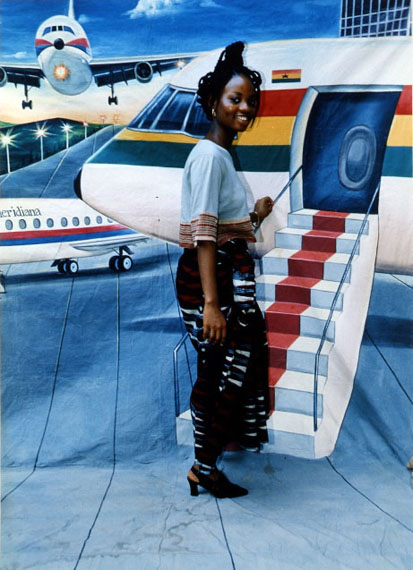
Come on Board, 2000
Chromogenic print
© Philip Kwame Apagya
Courtesy CAAC The Pigozzi Collection and Walther Collection
"Space & Photography" Exhibition: 25 November 2017 – 22 April 2018
Stereoscopic vision and conceptions of spatial dimensions, their extension and transformation are fundamentally at odds with the two-dimensional technically recorded image. Since the dawn of photography, this very incompatibility has prompted photographers to grapple with the question of how to represent space. The pioneering exhibition Space & Photography at the Museum der Moderne Salzburg surveys the history of this engagement with a selection of works by thirty-five artists from fourteen countries spanning the period from 1860 to the present. The exhibition’s thematic spectrum ranges from works by Wolfgang Tillmans and others that examine architectonic and virtual spaces, to photographs addressing social, economic, and conceptual questions, as in the work of Santu Mofokeng.
"As a center of expertise on artistic photography, we have designed this exhibition to tease out the interconnections between the photographic medium and sociopolitical questions around space, with a particular view to the recent renaissance of boundaries and standardizations," Sabine Breitwieser, Director of the Museum der Moderne Salzburg, explains. "Our objective is to shed light on photography’s formal and technical diversity as well as the evolution of genres and themes in a variety of geographical and sociopolitical contexts." Christiane Kuhlmann, the museum’s Curator of Photography and Media Art, underscores the historical depth and cultural breadth of the selection on view in Space & Photography: "In addition to examples from the early days of photography, we showcase contemporary works by artists whose non-European backgrounds and circumstances inform their perceptions and interpretations of space, complementing the long-dominant Eurocentric understanding with fresh perspectives." The photographic exhibits range from a walk-in camera obscura in which the lights of Salzburg’s old town limn a projected image to Hito Steyerl’s installation How Not to Be Seen (2013), which lets visitors somehow escape the encroachments of surveillance in public spaces and become invisible.
"Space & Photography" is divided into six thematic chapters. It opens with early imaging processes and experimental photography as the medium’s archetypical form. The second chapter traces the technological innovations of the nineteenth century, which propelled the emergence of new methods and capacities of the camera to imitate human ways of seeing and stereoscopy. In the early twentieth century, the development of modern camera technologies led to the genesis of the "Neues Sehen" or "New Vision"; in conjunction with the ideas of the "Neues Bauen" or "New Architecture," it gave rise to a novel perspective on architectonic space, the subject of another thematic focus. Exponents of the New Objectivity such as the photographer and Bauhaus teacher László Moholy-Nagy translated this shift into experimental conceptions of the photographic image that expanded the spectrum of visual impressions. The next chapters examine the photographic rendition of built space and architecture’s influence on society. Works by the conceptual artist Stephen Willats and the photographer Wolfgang Tillmans as well as the sculptor Isa Genzken address the expansion of the cities, suburbanization, and the rise of residential tower blocks. Tillmans’s video installation Book for Architects, which was presented at the 2014 Venice Architecture Biennale, attests to his fascination with life in the city as a kaleidoscope of widely divergent individual design decisions. With Allan Sekula and Noël Burch’s film The Forgotten Space (2010) and Dayanita Singh’s Museum of Chance (2015), the exhibition’s final section illuminates boundaries in political systems, economic spheres, and those spaces whose existence is primarily virtual.
�
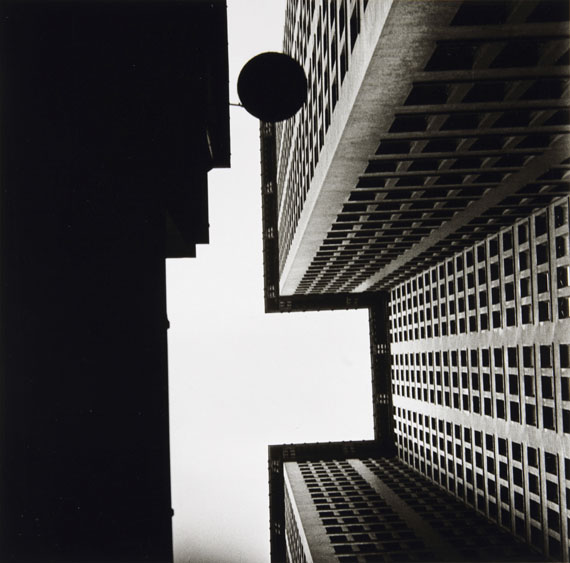
The Chase National Bank, New York, 1928
Gelatin silver print on Fiber-based paper
Courtesy FOTOGRAFIS Bank Austria Collection
"Raum & Fotografie"
Ausstellung: 25. November 2017 bis 22. April 2018
Räumliches Sehen und Vorstellungen von räumlichen Dimensionen, ihrer Ausdehnung und Veränderung entsprechen eigentlich nicht der Zweidimensionalität der technischen Aufnahme. Gerade aus diesem Grund setzen sich Fotograf_innen seit den Anfängen der Fotografie mit der Darstellung von Raum auseinander. In Raum & Fotografie präsentiert das Museum der Moderne Salzburg zu dieser Thematik erstmals Werke von 35 Künstler_innen aus vierzehn Ländern, mit Exponaten von 1860 bis heute. Das inhaltliche Spektrum der Ausstellung reicht von Arbeiten zu architektonischen und virtuellen Räumen, u. a. von Wolfgang Tillmans, bis hin zu Fotografien zu sozialen, ökonomischen und konzeptuellen Themen etwa von Santu Mofokeng. "Als Kompetenzzentrum für künstlerische Fotografie verknüpfen wir in dieser Ausstellung das Medium der Fotografie mit gesellschaftspolitischen Fragestellungen zum Raum, insbesondere auch zu immer häufiger auftretenden Grenzen und Normierungen", so Sabine Breitwieser, Direktorin am Museum der Moderne Salzburg. "Unser Anliegen ist es, Fotografie einerseits in formaler und technischer Hinsicht sowie andererseits in ihrer Entwicklung von Genres und Themen in unterschiedlichen geografischen und sozialpolitischen Zusammenhängen zu beleuchten." Die historische Tiefe und kulturelle Breite von Raum & Fotografie unterstreicht Christiane Kuhlmann, Kuratorin für Fotografie und Medienkunst: "Wir zeigen neben Arbeiten aus der Anfangszeit der Fotografie vor allem auch zeitgenössische Werke von Künstler_innen, die von außerhalb Europas stammen und aufgrund ihrer unterschiedlichen sozialen Prägungen und Lebensbedingungen Raum anders wahrnehmen und interpretieren, als es aus eurozentrischer Sicht lange Zeit üblich war." Die fotografischen Exponate reichen von einer begehbaren Camera obscura, in der das Licht der Salzburger Altstadt zum projizierten Bild wird, bis hin zu der Installation How Not to Be Seen (2013) von Hito Steyerl, in der man – entgegen aktueller Überwachungsszenarien – unsichtbar werden kann.
Thematisch gliedert sich die Ausstellung Raum & Fotografie in sechs Kapitel, beginnend mit frühen Bildverfahren und experimenteller Fotografie als Urform des Mediums. Mit den technischen Entwicklungen des 19. Jahrhunderts und damit einhergehenden neuen Methoden und Möglichkeiten der Kamera, menschliche Sichtweisen und räumliches Sehen zu imitieren, beginnt das nächste Ausstellungskapitel. Dem "Neuen Sehen", das im frühen 20. Jahrhundert durch die Entwicklung moderner Kameratechniken entstand und zusammen mit den Ideen des "Neuen Bauens" eine Neubetrachtung des architektonischen Raums mit sich brachte, ist ein weiterer Themenschwerpunkt gewidmet. Neusachliche Fotograf_innen wie der Bauhauslehrer László Moholy-Nagy nahmen diese Neubetrachtung zum Anlass für ihre experimentellen Bildkonzepte, die eine Erweiterung der Seheindrücke ermöglichten. Die anschließenden Kapitel befassen sich mit der fotografischen Wiedergabe des gebauten Raums und dem Einfluss von Architektur auf die Gesellschaft. Die Expansion der Städte mit der Entstehung von Randbezirken und Wohntürmen ist ein Thema der Arbeiten des Konzeptkünstlers Stephen Willats und des Fotografen Wolfgang Tillmans, aber auch der Bildhauerin Isa Genzken. Die Videoinstallation Book for Architects von Tillmanns, die 2014 auf der Architekturbiennale in Venedig vorgestellt wurde, zeugt von der Faszination, die das Leben in der Stadt und die gegensätzlichen gestalterischen Einzelentscheidungen für den Künstler haben. Mit dem Film The Forgotten Space (2010) von Allan Sekula und Noël Burch und Dayanita Singhs Museum of Chance von 2015 widmet sich der abschließende Teil der Ausstellung den Grenzen in politischen Systemen, Wirtschaftsräumen und solchen, die vor allem virtuell bestehen.
�
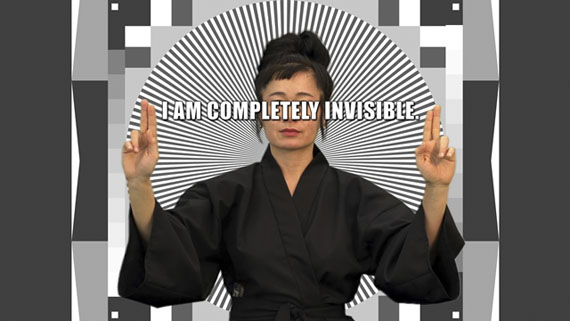
HOW NOT TO BE SEEN: A Fucking Didactic Educational .MOV File, 2013
Still image, single screen, chromogenic prints, C- Stative, Floor installation
Courtesy Hito Steyerl and Andrew Kreps Gallery, New York
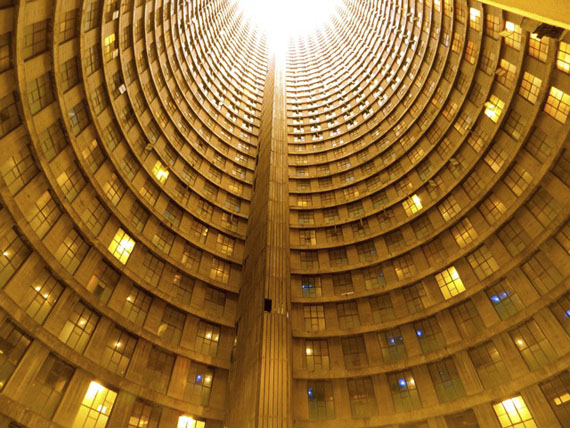
Africa Shafted: under one roof, 2011
Filmstill
© IM Original Films, Johannesburg